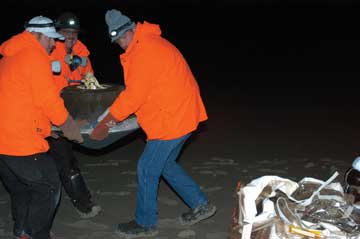|
News Notes
Space
Surprise! Stardust lands actual stardust
 |
| NASA’s Stardust sample return capsule successfully landed at the U.S. Air Force Utah Test and Training Range. The capsule contains cometary and interstellar samples gathered by the Stardust spacecraft, with new studies of the samples revealing much about the early solar system. Photograph is courtesy of NASA. |
The dust is clearing around a cosmic puzzle that has long piqued the interest of astronomers. Tiny grains of dust, no larger than the width of a human hair, are revealing the conditions in which the solar system, and perhaps life, got its start.
In 1999, NASA sent the spacecraft Stardust on a mission to collect some of the particles sloughed off Wild 2 — a comet born beyond Neptune that only recently entered the inner solar system. In 2004, Stardust passed through a cloud of dust and gas surrounding the comet, trapping dust grains in a racquet-shaped tray. Then in January 2006, after traveling more than 3 billion kilometers, the craft dropped its dusty load to Earth in a sealed capsule. Now, results are in from a plethora of studies of the tiny grains of comet dust, and the findings, reported Dec. 15 in Science, point toward a tumultuous beginning for our solar system.
Comets, sometimes referred to as “dirty snowballs,” are conglomerations of ice and dust that have long been thought to form in isolation in the frigid outer solar system: either beyond Neptune in the disk of debris called the Kuiper Belt, or in the more distant reservoir of comets called the Oort Cloud. Researchers found, however, that at least one dust grain collected from Wild 2 arose closer in, near the sizzling-hot sun, says Scott Sandford, a Stardust co-investigator from NASA’s Ames Research Center.
Astronomers previously suspected that comets act like celestial deep-freezers, preserving the building blocks of the solar system in their original forms. So finding an element born in extreme heat was a surprise. “We found the hottest mineral that’s ever existed naturally in the solar system in this very cold place,” says Donald Brownlee of the University of Washington, and principal investigator of the Stardust mission. The presence of that particle — nicknamed Inti after the Incan sun god — in a comet cobbled together in the coldest depths of space suggests “mixing on a really large scale,” Sandford says, contrary to previous thinking.
“These results clearly show” that the solar nebula — the rotating disk of gas and debris that eventually formed our solar system — “was not a nice little sedate place,” Sandford says. “When the solar system formed, the solar nebula had to have been mixing like a son of a gun.”
Researchers developing models to explain how the solar system formed have long considered this possibility, but until now had little proof. Nevertheless, how this mixing occurred is still up for debate. Some suggest that solar winds emanating from the sun’s poles blasted particles out of the solar nebula into space, leaving them to fall back into more distant parts of the nebula. Others speculate that turbulent exchanges occurred within the nebula. Despite the uncertainty, however, one thing is clear: Any early solar system model that fails to accommodate large-scale mixing “is a goner,” Sandford says.
The newfound evidence does not make theorists’ jobs any easier. Researchers who preferred a “simple picture” of solar system formation, would have found it “much more convenient” if the particles had not mixed, arising instead from the gas and dust that fills the space between stars, says Michael A’Hearn, an astronomer at the University of Maryland. And although some models of solar system formation do take mixing into account, “there are still some missing pieces,” says Alan Boss of the Carnegie Institution of Washington. Combining ideas from different models will bring scientists closer to understanding the basic forces that shaped the solar system, he says.
By studying the comet dust, the Stardust team also hopes to learn something about the origins of life on Earth, Sandford says, as comets may have been responsible for bringing the most basic organic materials to Earth’s surface after the planet coalesced and cooled. “A portion of the organic material in the samples [from Wild 2] is unlike anything seen before in extraterrestrial materials,” he says. The nitrogen- and oxygen-rich organics are different from those found in meteorites or in “interstellar” dust, indicating that they originated in the solar nebula or in dense space clouds. “These are likely starting materials for life on Earth,” Boss says.
Although questions remain, Sandford anticipates new discoveries are still to come, as Stardust’s samples will be turned over to NASA’s Johnson Space Center so that they can be made available to scientists for generations to come. In the future, more powerful tools and techniques might help unlock the secrets trapped in the tiny specks of comet dust. “The real goal,” A’Hearn says, “is to understand how we got here.”
Cassandra Willyard
Geotimes contributing writer

 Subscribe
Subscribe

